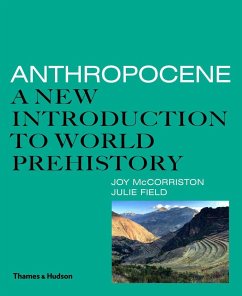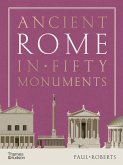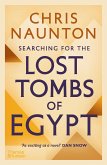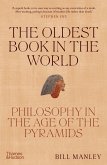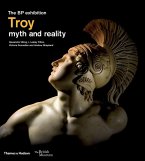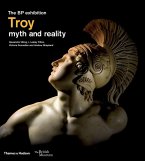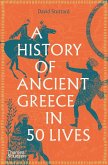- Broschiertes Buch
- Merkliste
- Auf die Merkliste
- Bewerten Bewerten
- Teilen
- Produkt teilen
- Produkterinnerung
- Produkterinnerung
A groundbreaking new textbook that brings a highly topical, environmental perspective to the story of how humans have shaped the world.
Andere Kunden interessierten sich auch für
![Ancient Rome in Fifty Monuments Ancient Rome in Fifty Monuments]() Paul RobertsAncient Rome in Fifty Monuments33,99 €
Paul RobertsAncient Rome in Fifty Monuments33,99 €![Searching for the Lost Tombs of Egypt Searching for the Lost Tombs of Egypt]() Chris NauntonSearching for the Lost Tombs of Egypt20,99 €
Chris NauntonSearching for the Lost Tombs of Egypt20,99 €![The Oldest Book in the World The Oldest Book in the World]() Bill ManleyThe Oldest Book in the World32,99 €
Bill ManleyThe Oldest Book in the World32,99 €![Troy: myth and reality (British Museum) Troy: myth and reality (British Museum)]() Alexandra VillingTroy: myth and reality (British Museum)33,99 €
Alexandra VillingTroy: myth and reality (British Museum)33,99 €![Troy: myth and reality (British Museum) Troy: myth and reality (British Museum)]() Alexandra VillingTroy: myth and reality (British Museum)48,99 €
Alexandra VillingTroy: myth and reality (British Museum)48,99 €![A History of Ancient Greece in 50 Lives A History of Ancient Greece in 50 Lives]() David StuttardA History of Ancient Greece in 50 Lives20,99 €
David StuttardA History of Ancient Greece in 50 Lives20,99 €![The Enemies of Rome The Enemies of Rome]() Philip MatyszakThe Enemies of Rome22,99 €
Philip MatyszakThe Enemies of Rome22,99 €-
-
-
A groundbreaking new textbook that brings a highly topical, environmental perspective to the story of how humans have shaped the world.
Hinweis: Dieser Artikel kann nur an eine deutsche Lieferadresse ausgeliefert werden.
Hinweis: Dieser Artikel kann nur an eine deutsche Lieferadresse ausgeliefert werden.
Produktdetails
- Produktdetails
- Verlag: Thames & Hudson Ltd
- Seitenzahl: 376
- Erscheinungstermin: 2. Januar 2020
- Englisch
- Abmessung: 228mm x 192mm x 25mm
- Gewicht: 952g
- ISBN-13: 9780500052143
- ISBN-10: 050005214X
- Artikelnr.: 58449770
- Herstellerkennzeichnung
- Libri GmbH
- Europaallee 1
- 36244 Bad Hersfeld
- gpsr@libri.de
- Verlag: Thames & Hudson Ltd
- Seitenzahl: 376
- Erscheinungstermin: 2. Januar 2020
- Englisch
- Abmessung: 228mm x 192mm x 25mm
- Gewicht: 952g
- ISBN-13: 9780500052143
- ISBN-10: 050005214X
- Artikelnr.: 58449770
- Herstellerkennzeichnung
- Libri GmbH
- Europaallee 1
- 36244 Bad Hersfeld
- gpsr@libri.de
Joy McCorriston is Professor of Anthropology at The Ohio State University. She researches food production, landscape and paleoenvironments in the ancient Near East and co-directs field research in Arabia.
1. Archaeology and the Anthropocene What Is the Anthropocene? . The
Perspective of Archaeology . Polynesia and the North Atlantic: Islands as
Laboratories . Methods: Survey and Excavation . How Have Humans Made
Their World?
2. Discovering Diversity: Modern Human Origins Diversity of Humans: Homo
sapiens and Neanderthals . Modern Humans . Lascaux Cave and the Human
Experience of the Ice Age . Additional Human Experiences in the Ice Age .
Human Culture Begins to Shape the Anthropocene . Protecting Cultural
Diversity
Global Timeline 1: Human Origins and Migrations
3. Technology Makes the Human: Stone, Metal, and Organic Material Culture
Stone Tools and the Discovery of Time . The Mechanics of Flintknapping .
Stone Tools as Evidence of Human Adaptation . Metalworking, a New
Technology for Communities . Perishable Technologies: Revelations from the
Iceman . Technology, the Environment, and the Anthropocene
4. Peopling the World: Human Dispersals to Australia, the Americas,
and the Pacific Inhabiting Australia . Human Dispersals in the Americas .
Inhabiting the Pacific . Methods: Archaeological Survey . Peopling and the
Anthropocene
Global Timeline 2: People and Societies
5. Digging In: Responding to Climate Change in the American Southwest The
American Southwest . Methods: Excavation . The Colorado Plateau and the
Chaco Phenomenon . Understanding Ancient Pueblo Society: Broken K Pueblo .
Other People of the Southwest . The Southwest and the Changing Environment
6. Extinctions in the Past Big Game Hunters: The Clovis People .
Radiocarbon Dating . The Spread of Clovis . Hunting Megafauna . Mastodons
and the Role of a Changing Environment . South America: The Giant
Ground Sloth . The Role of Humans in Extinction Events
7. Understanding Human Decisions: Evolutionary and Social Theory Bison
Hunters of the American Great Plains . Zooarchaeology . Bison Hunting and
Butchering in Context . South Pacific: Conflict and Fortification in Fiji .
Europe: Deciding With or Against a Community in St. Kilda . The Amazon:
Decision-Making Today
8. Producing Food: Domestication and Its Consequences in Southwest and East
Asia Southwest Asia: The First Settlements . What Led to the Development
of Farming? . Archaebotany and the Evidence for Food Production .
Domestication: A Two-Way Process . China: Independent Domestication
and Rice . The Consequences of Farming . The Critical Role of the Community
in Food Production
Global Timeline 3: Domestication
9. Individuals and Identity: Agency in History Studying Identity .
Mesoamerica: The Aztecs . Cortés and La Malinché . Textiles, Identity, and
Gender . Bioarchaeology . Inequality and Structural Violence in Prehistory
. Agency, Identity, and the Anthropocene
10. Feeding Cities: Urbanism and Agriculture Mesoamerica: Discovering
the Maya . Maize and the Maya . The Maya City . Southeast Asia: Irrigation
and Agriculture at Angkor . The State . The Environmental Perils
of Intensification . Cities, Surplus, and the Elite
11. Building Monuments, Building Society: Collective Labor as
Social Identity Monuments and Landscapes . Ancient Egypt: Building the
Egyptian State . Monuments Among Mobile Communities . Stonehenge and the
Pastoralist Landscape of Neolithic Britain . North America: The Hopewell
Earthworks
12. Conspicuous Consumption: Feasts, Burials, and Sacrifice Chiefs and
Hoards . Feasting . Residue Analysis . Reciprocity . The Ultimate
Sacrifice: Human . Europe: The Burial of Viking and Anglo-Saxon Ships . Is
Conspicuous Consumption Inevitable?
13. Writing: A History of Access to Information Writing in Many Contexts .
Writings of the Maya . Writings of the Sumerians . Ancient Chinese Writing
. Alphabetic Writing . Preservation of Writing Systems . Without Writing:
Systems of Notation . North Africa and Arabia: Literacy without Settlement
. Writing and the Anthropocene
14. Extracting the Modern World: Fishing, Mining, and Slavery Extractivism,
Markets, and the Environment . Fishing and Maritime Extractivism .
Underwater Archaeology . Extracted Minerals in the New World . Extracting
People: The Slave Trade . Extractivism and the Anthropocene
15. The Future of the Anthropocene The Challenges Ahead . Extinctions and
Increasing Diversity . Population Growth . Fossil-Fuel Consumption
and Innovation . Understand Your Agency
Glossary Sources of Quotations
Sources of Illustrations
Index
Perspective of Archaeology . Polynesia and the North Atlantic: Islands as
Laboratories . Methods: Survey and Excavation . How Have Humans Made
Their World?
2. Discovering Diversity: Modern Human Origins Diversity of Humans: Homo
sapiens and Neanderthals . Modern Humans . Lascaux Cave and the Human
Experience of the Ice Age . Additional Human Experiences in the Ice Age .
Human Culture Begins to Shape the Anthropocene . Protecting Cultural
Diversity
Global Timeline 1: Human Origins and Migrations
3. Technology Makes the Human: Stone, Metal, and Organic Material Culture
Stone Tools and the Discovery of Time . The Mechanics of Flintknapping .
Stone Tools as Evidence of Human Adaptation . Metalworking, a New
Technology for Communities . Perishable Technologies: Revelations from the
Iceman . Technology, the Environment, and the Anthropocene
4. Peopling the World: Human Dispersals to Australia, the Americas,
and the Pacific Inhabiting Australia . Human Dispersals in the Americas .
Inhabiting the Pacific . Methods: Archaeological Survey . Peopling and the
Anthropocene
Global Timeline 2: People and Societies
5. Digging In: Responding to Climate Change in the American Southwest The
American Southwest . Methods: Excavation . The Colorado Plateau and the
Chaco Phenomenon . Understanding Ancient Pueblo Society: Broken K Pueblo .
Other People of the Southwest . The Southwest and the Changing Environment
6. Extinctions in the Past Big Game Hunters: The Clovis People .
Radiocarbon Dating . The Spread of Clovis . Hunting Megafauna . Mastodons
and the Role of a Changing Environment . South America: The Giant
Ground Sloth . The Role of Humans in Extinction Events
7. Understanding Human Decisions: Evolutionary and Social Theory Bison
Hunters of the American Great Plains . Zooarchaeology . Bison Hunting and
Butchering in Context . South Pacific: Conflict and Fortification in Fiji .
Europe: Deciding With or Against a Community in St. Kilda . The Amazon:
Decision-Making Today
8. Producing Food: Domestication and Its Consequences in Southwest and East
Asia Southwest Asia: The First Settlements . What Led to the Development
of Farming? . Archaebotany and the Evidence for Food Production .
Domestication: A Two-Way Process . China: Independent Domestication
and Rice . The Consequences of Farming . The Critical Role of the Community
in Food Production
Global Timeline 3: Domestication
9. Individuals and Identity: Agency in History Studying Identity .
Mesoamerica: The Aztecs . Cortés and La Malinché . Textiles, Identity, and
Gender . Bioarchaeology . Inequality and Structural Violence in Prehistory
. Agency, Identity, and the Anthropocene
10. Feeding Cities: Urbanism and Agriculture Mesoamerica: Discovering
the Maya . Maize and the Maya . The Maya City . Southeast Asia: Irrigation
and Agriculture at Angkor . The State . The Environmental Perils
of Intensification . Cities, Surplus, and the Elite
11. Building Monuments, Building Society: Collective Labor as
Social Identity Monuments and Landscapes . Ancient Egypt: Building the
Egyptian State . Monuments Among Mobile Communities . Stonehenge and the
Pastoralist Landscape of Neolithic Britain . North America: The Hopewell
Earthworks
12. Conspicuous Consumption: Feasts, Burials, and Sacrifice Chiefs and
Hoards . Feasting . Residue Analysis . Reciprocity . The Ultimate
Sacrifice: Human . Europe: The Burial of Viking and Anglo-Saxon Ships . Is
Conspicuous Consumption Inevitable?
13. Writing: A History of Access to Information Writing in Many Contexts .
Writings of the Maya . Writings of the Sumerians . Ancient Chinese Writing
. Alphabetic Writing . Preservation of Writing Systems . Without Writing:
Systems of Notation . North Africa and Arabia: Literacy without Settlement
. Writing and the Anthropocene
14. Extracting the Modern World: Fishing, Mining, and Slavery Extractivism,
Markets, and the Environment . Fishing and Maritime Extractivism .
Underwater Archaeology . Extracted Minerals in the New World . Extracting
People: The Slave Trade . Extractivism and the Anthropocene
15. The Future of the Anthropocene The Challenges Ahead . Extinctions and
Increasing Diversity . Population Growth . Fossil-Fuel Consumption
and Innovation . Understand Your Agency
Glossary Sources of Quotations
Sources of Illustrations
Index
1. Archaeology and the Anthropocene What Is the Anthropocene? . The
Perspective of Archaeology . Polynesia and the North Atlantic: Islands as
Laboratories . Methods: Survey and Excavation . How Have Humans Made
Their World?
2. Discovering Diversity: Modern Human Origins Diversity of Humans: Homo
sapiens and Neanderthals . Modern Humans . Lascaux Cave and the Human
Experience of the Ice Age . Additional Human Experiences in the Ice Age .
Human Culture Begins to Shape the Anthropocene . Protecting Cultural
Diversity
Global Timeline 1: Human Origins and Migrations
3. Technology Makes the Human: Stone, Metal, and Organic Material Culture
Stone Tools and the Discovery of Time . The Mechanics of Flintknapping .
Stone Tools as Evidence of Human Adaptation . Metalworking, a New
Technology for Communities . Perishable Technologies: Revelations from the
Iceman . Technology, the Environment, and the Anthropocene
4. Peopling the World: Human Dispersals to Australia, the Americas,
and the Pacific Inhabiting Australia . Human Dispersals in the Americas .
Inhabiting the Pacific . Methods: Archaeological Survey . Peopling and the
Anthropocene
Global Timeline 2: People and Societies
5. Digging In: Responding to Climate Change in the American Southwest The
American Southwest . Methods: Excavation . The Colorado Plateau and the
Chaco Phenomenon . Understanding Ancient Pueblo Society: Broken K Pueblo .
Other People of the Southwest . The Southwest and the Changing Environment
6. Extinctions in the Past Big Game Hunters: The Clovis People .
Radiocarbon Dating . The Spread of Clovis . Hunting Megafauna . Mastodons
and the Role of a Changing Environment . South America: The Giant
Ground Sloth . The Role of Humans in Extinction Events
7. Understanding Human Decisions: Evolutionary and Social Theory Bison
Hunters of the American Great Plains . Zooarchaeology . Bison Hunting and
Butchering in Context . South Pacific: Conflict and Fortification in Fiji .
Europe: Deciding With or Against a Community in St. Kilda . The Amazon:
Decision-Making Today
8. Producing Food: Domestication and Its Consequences in Southwest and East
Asia Southwest Asia: The First Settlements . What Led to the Development
of Farming? . Archaebotany and the Evidence for Food Production .
Domestication: A Two-Way Process . China: Independent Domestication
and Rice . The Consequences of Farming . The Critical Role of the Community
in Food Production
Global Timeline 3: Domestication
9. Individuals and Identity: Agency in History Studying Identity .
Mesoamerica: The Aztecs . Cortés and La Malinché . Textiles, Identity, and
Gender . Bioarchaeology . Inequality and Structural Violence in Prehistory
. Agency, Identity, and the Anthropocene
10. Feeding Cities: Urbanism and Agriculture Mesoamerica: Discovering
the Maya . Maize and the Maya . The Maya City . Southeast Asia: Irrigation
and Agriculture at Angkor . The State . The Environmental Perils
of Intensification . Cities, Surplus, and the Elite
11. Building Monuments, Building Society: Collective Labor as
Social Identity Monuments and Landscapes . Ancient Egypt: Building the
Egyptian State . Monuments Among Mobile Communities . Stonehenge and the
Pastoralist Landscape of Neolithic Britain . North America: The Hopewell
Earthworks
12. Conspicuous Consumption: Feasts, Burials, and Sacrifice Chiefs and
Hoards . Feasting . Residue Analysis . Reciprocity . The Ultimate
Sacrifice: Human . Europe: The Burial of Viking and Anglo-Saxon Ships . Is
Conspicuous Consumption Inevitable?
13. Writing: A History of Access to Information Writing in Many Contexts .
Writings of the Maya . Writings of the Sumerians . Ancient Chinese Writing
. Alphabetic Writing . Preservation of Writing Systems . Without Writing:
Systems of Notation . North Africa and Arabia: Literacy without Settlement
. Writing and the Anthropocene
14. Extracting the Modern World: Fishing, Mining, and Slavery Extractivism,
Markets, and the Environment . Fishing and Maritime Extractivism .
Underwater Archaeology . Extracted Minerals in the New World . Extracting
People: The Slave Trade . Extractivism and the Anthropocene
15. The Future of the Anthropocene The Challenges Ahead . Extinctions and
Increasing Diversity . Population Growth . Fossil-Fuel Consumption
and Innovation . Understand Your Agency
Glossary Sources of Quotations
Sources of Illustrations
Index
Perspective of Archaeology . Polynesia and the North Atlantic: Islands as
Laboratories . Methods: Survey and Excavation . How Have Humans Made
Their World?
2. Discovering Diversity: Modern Human Origins Diversity of Humans: Homo
sapiens and Neanderthals . Modern Humans . Lascaux Cave and the Human
Experience of the Ice Age . Additional Human Experiences in the Ice Age .
Human Culture Begins to Shape the Anthropocene . Protecting Cultural
Diversity
Global Timeline 1: Human Origins and Migrations
3. Technology Makes the Human: Stone, Metal, and Organic Material Culture
Stone Tools and the Discovery of Time . The Mechanics of Flintknapping .
Stone Tools as Evidence of Human Adaptation . Metalworking, a New
Technology for Communities . Perishable Technologies: Revelations from the
Iceman . Technology, the Environment, and the Anthropocene
4. Peopling the World: Human Dispersals to Australia, the Americas,
and the Pacific Inhabiting Australia . Human Dispersals in the Americas .
Inhabiting the Pacific . Methods: Archaeological Survey . Peopling and the
Anthropocene
Global Timeline 2: People and Societies
5. Digging In: Responding to Climate Change in the American Southwest The
American Southwest . Methods: Excavation . The Colorado Plateau and the
Chaco Phenomenon . Understanding Ancient Pueblo Society: Broken K Pueblo .
Other People of the Southwest . The Southwest and the Changing Environment
6. Extinctions in the Past Big Game Hunters: The Clovis People .
Radiocarbon Dating . The Spread of Clovis . Hunting Megafauna . Mastodons
and the Role of a Changing Environment . South America: The Giant
Ground Sloth . The Role of Humans in Extinction Events
7. Understanding Human Decisions: Evolutionary and Social Theory Bison
Hunters of the American Great Plains . Zooarchaeology . Bison Hunting and
Butchering in Context . South Pacific: Conflict and Fortification in Fiji .
Europe: Deciding With or Against a Community in St. Kilda . The Amazon:
Decision-Making Today
8. Producing Food: Domestication and Its Consequences in Southwest and East
Asia Southwest Asia: The First Settlements . What Led to the Development
of Farming? . Archaebotany and the Evidence for Food Production .
Domestication: A Two-Way Process . China: Independent Domestication
and Rice . The Consequences of Farming . The Critical Role of the Community
in Food Production
Global Timeline 3: Domestication
9. Individuals and Identity: Agency in History Studying Identity .
Mesoamerica: The Aztecs . Cortés and La Malinché . Textiles, Identity, and
Gender . Bioarchaeology . Inequality and Structural Violence in Prehistory
. Agency, Identity, and the Anthropocene
10. Feeding Cities: Urbanism and Agriculture Mesoamerica: Discovering
the Maya . Maize and the Maya . The Maya City . Southeast Asia: Irrigation
and Agriculture at Angkor . The State . The Environmental Perils
of Intensification . Cities, Surplus, and the Elite
11. Building Monuments, Building Society: Collective Labor as
Social Identity Monuments and Landscapes . Ancient Egypt: Building the
Egyptian State . Monuments Among Mobile Communities . Stonehenge and the
Pastoralist Landscape of Neolithic Britain . North America: The Hopewell
Earthworks
12. Conspicuous Consumption: Feasts, Burials, and Sacrifice Chiefs and
Hoards . Feasting . Residue Analysis . Reciprocity . The Ultimate
Sacrifice: Human . Europe: The Burial of Viking and Anglo-Saxon Ships . Is
Conspicuous Consumption Inevitable?
13. Writing: A History of Access to Information Writing in Many Contexts .
Writings of the Maya . Writings of the Sumerians . Ancient Chinese Writing
. Alphabetic Writing . Preservation of Writing Systems . Without Writing:
Systems of Notation . North Africa and Arabia: Literacy without Settlement
. Writing and the Anthropocene
14. Extracting the Modern World: Fishing, Mining, and Slavery Extractivism,
Markets, and the Environment . Fishing and Maritime Extractivism .
Underwater Archaeology . Extracted Minerals in the New World . Extracting
People: The Slave Trade . Extractivism and the Anthropocene
15. The Future of the Anthropocene The Challenges Ahead . Extinctions and
Increasing Diversity . Population Growth . Fossil-Fuel Consumption
and Innovation . Understand Your Agency
Glossary Sources of Quotations
Sources of Illustrations
Index

